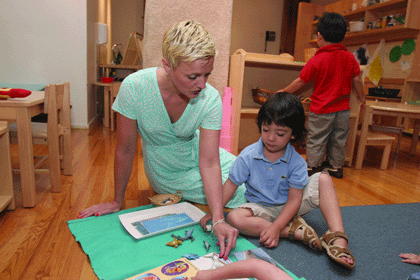By Jefferson Siegel
As Downtown’s population continues to grow at a feverish pace, the few public schools serving the area are filling up. The only new public facilities planned in the immediate future are a new K-8 school on Beekman St. and an annex to P.S. 234. Smaller private and specialty schools have been opening to fill the academic needs of local families.
One school giving the youngest local residents a head start on their educational lives is the Montessori School of Manhattan at 53 Beach St. between Greenwich and Hudson Sts. A private school for children between the ages of 2 and 6, Tribeca’s Montessori offers full-time and part-time morning and afternoon programs.
The school is accredited by the American Montessori Society, which examines every aspect of a school’s identity, from teacher credentials to what’s on the school’s bookshelves, before granting accreditation.
“The approach in a Montessori program is completely individualized, so children are challenged to the highest level of their own individual ability,” explained Head of School Bridie Gauthier. Children learn with a hands-on approach, “so they’re never expected to absorb an abstract concept before they’ve actually had a concrete experience with it,” Gauthier said. The Montessori approach is intended for children to absorb more with these direct experiences than just having an idea explained to them.
Earlier this month, a yoga teacher at the school, Naomi Jaffe, stretched her arms to the ceiling in front of several children. The toddlers responded in their own ways. In fact, one little girl kept crawling between Jaffe’s legs, perhaps doing her own “London Bridge is falling down” pose, but it certainly exemplified the hands-on concept.
Gauthier explained that Dr. Maria Montessori, founder of the eponymous educational method, identified children from birth to age 6 as being in a period of life she called the “absorbent mind.”
“It’s when the most critical facets of language development are occurring,” Gauthier said. “Children are exploring the world through their senses. The more opportunities that you provide, especially in a structured-rich environment, they’re just constantly looking for these new experiences.”
Classes offered by the Tribeca school for children age 2 and up include French, Spanish, music, movement, drama, performing arts, yoga and art. The half-hour classes are taught by teachers who are specialists in each field. Gauthier explained that the traditional Montessori classroom is divided into five areas: math, language, practical life (daily living skills), sensorial skills (color, touch, taste) and culture (science and history).
Toddler classes consist of 10 children and two teachers; preschool classes are comprised of 16 students and two teachers. Certified teachers have a New York State license and have completed a two-year intensive course of study in Montessori methods. Gauthier equated the two-year course to a master’s degree.
“It takes a very special kind of person to be able to embrace the concept and then implement it in the classroom,” she said.
“The classrooms are completely set up for the children,” she explained. “There are no adult desks, there’s no sitting in rows. Even the pictures are hung 3 feet off the floor. It’s all designed specifically for the children.”
“There’s a great focus on community-building so that they [the children] are understanding the interdependency of each other, understanding how we all affect one another, logical consequences,” Gauthier added.
When the Beach St. location opened in 2003, there were 22 children on one floor of the building. This year attendance has grown to 200 students and the school just expanded onto their third floor.
When Soho parent Michelle Williams was looking for a preschool close to home, neighborhood residents recommended Montessori.
“I think it’s an excellent fit for our daughter,” she said of her 3-year-old. “She has learned so much, the environment is so nurturing,” Williams said.
Next September, Gauthier will help launch another Montessori school at 2 Gold St. near Wall St. The Montessori School of Manhattan Wall St. Campus will be three times the size of the current Tribeca location and, at 15,000 square feet, will include 10 classrooms and a full gymnasium, as well as an art studio and outdoor play area. Gauthier anticipates a student population of between 200 to 300 children, from 2 years old through kindergarten age. The curriculum will mirror that of the Tribeca location.
One new program at the Wall St. campus will be the availability of extended-hours care, “because we anticipate that a lot of the draw is going to be from the Financial District parents who work in the area and want their children close by,” Gauthier explained.
Down the road, Gauthier envisions a full elementary school Downtown. And, another school above Canal St. is also being considered.
Gauthier has been an educator for 17 years. Starting as a public school teacher in Ontario, Canada, she came to New York for Montessori training and stayed.
“My job is the best gig in town,” she enthused. “The population here at this school is really reflective of the community. It’s a lovely place to be. It’s just a pleasure to come to work every day.”
The Tribeca Montessori school will host two open houses in September. The first, on Thurs. Sept. 21 from 6 p.m. to 7:30 p.m., will showcase the Beach St. location. A second, on Wed. Sept. 27, also at the Beach St. school, from 6 p.m. to 7:30 p.m., will highlight the future Wall St. campus.



























